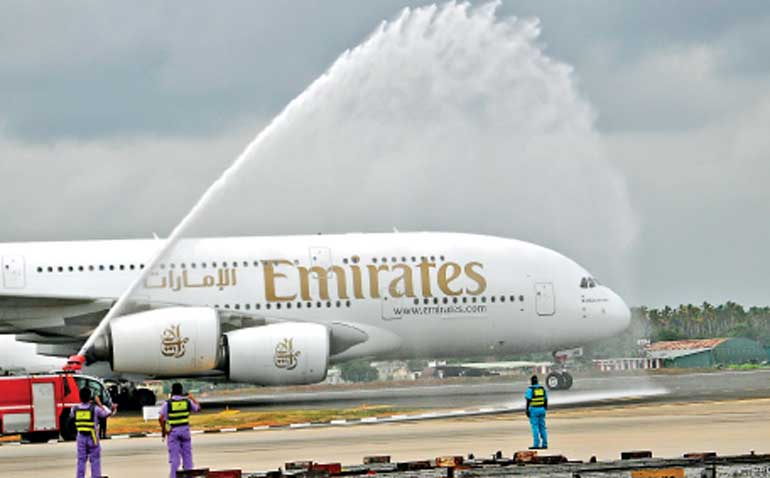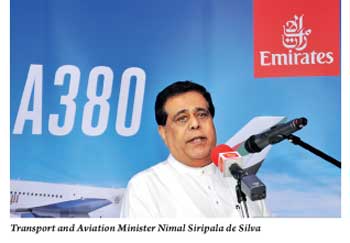Friday Mar 28, 2025
Friday Mar 28, 2025
Saturday, 19 August 2017 00:38 - - {{hitsCtrl.values.hits}}
 The landing of an Emirates A380 plane at the BIA a few days back was a landmark event in Sri Lanka’s aviation history dating back to a little over a century. It was the climax of a long journey from the day that the first flight was made at the Colombo racecourse in a Bleriot monoplane. The recorded date is 7 December 1912.
The landing of an Emirates A380 plane at the BIA a few days back was a landmark event in Sri Lanka’s aviation history dating back to a little over a century. It was the climax of a long journey from the day that the first flight was made at the Colombo racecourse in a Bleriot monoplane. The recorded date is 7 December 1912.
Not much was heard thereafter until the arrival of a De Havilland Puss Moth flown by Tyndalle Biscoe, Chief Flying Instructor of the Madras Flying Club on 27 November 1935 at the Ratmalana aerodrome. Construction work of a standalone destination with a runway of 600 yards had begun after the State Council selected Kandawela Estate in 1934.

Ratmalana, designated as the Colombo Airport, was ceremonially opened on 28 February 1938 by Governor Sir Andrew Caldecott (1937-44) by launching the Air Mail service between Colombo and Bombay (now Mumbai), using the mail room at the aerodrome. A Tata Airlines Waco plane took off from Ratmalana carrying mail officially linking Ceylon to the Empire Airmail Service.
Ratmalana was a busy place during the Second World War when it was used as a Royal Air Force (RAF) base with No. 30 Squadron flying Hawker Hurricanes against the Japanese Navy aircraft. Meanwhile, the RAF built another base at the present BIA site at Katunayake.
RAF also set up a flying boat base at the lake at Koggala from where RAF flew Catalina flying boats. The service became vital to the British/Australian war effort after the Japanese occupied the Malay Peninsula in 1942 resulting in the loss of Singapore, the refuelling point of the Qantas Empire Airways Indian Ocean flight from London to Sydney.
An alternate route was established from the Koggala Lake to Swan River in Perth – the longest non-stop air route at the time. The planes carried three passengers and 600 kilograms of mail. It took 28 hours. With the passengers seeing the sunrise twice, it came to be known as ‘the flight of double sunrise’.
![]() After WWII was over, J.P. Obeysekera piloted an Autocrat aircraft from London with 31 intermediate stops landing at Ratmalana after 103 hours 30 minutes on 13 November 1946.
After WWII was over, J.P. Obeysekera piloted an Autocrat aircraft from London with 31 intermediate stops landing at Ratmalana after 103 hours 30 minutes on 13 November 1946.
National carrier launched
With things settling down after the war, in 1947 the Government set up Air Ceylon as the first State-owned flag carrier airline. Three 3DC-3s (Dakotas) were purchased and were given names of three ancient queens – Sita Devi, Viharamaha Devi and Sunethra Devi.
Commercial flights began on 10 December 1947 when 16 passengers were taken from Ratmalana to Palaly. After a brief stop it took off for Madras and returned the same day. Captain Peter Fernando was at the controls with 16 passengers on the inaugural flight.
From time to time Air Ceylon made leasing and other arrangements with several international airlines and maintained international services.
With the decision in 1957 by Prime Minister Bandaranaike to take over all British military airfields and naval bases, RAF base at Katunayake was handed over to the Royal Ceylon Air Force (RCyAF). In 1964, it was decided to build a new international airport with Canadian aid at Katunayake adjoining the Air Force base. The construction was completed in 1967 and Air Ceylon began international flights from there using a Hawker Sideley Trident and a leased BOAC VC-10. A landmark event at the Katunayake Airport – renamed Bandaranaike International Airport in 1970 after former Prime Minister – took place on 7 November 1971 when the first Boeing 747 operated by Condor carrying German tourists from Frankfurt landed at BIA. Since then the airport has seen many extensions and improvements alongside technological advances. The national carrier has also seen many a change. Air Ceylon was shut down due to bankruptcy and Air Lanka took its place in 1979. The State-owned airline was partially privatised in 1998 with investment by Dubai-based Emirates Group. It was then re-branded as SriLankan Airlines. Presently there is talk about changes in the national airline. The arrival of the A380 with 500 passengers was lauded by Transport and Aviation Minister Nimal Siripala de Silva with the words: “The arrival of the world’s largest commercial aircraft lifts the confidence of the airport status of BIA.”
Pix by Ruwan Walpola